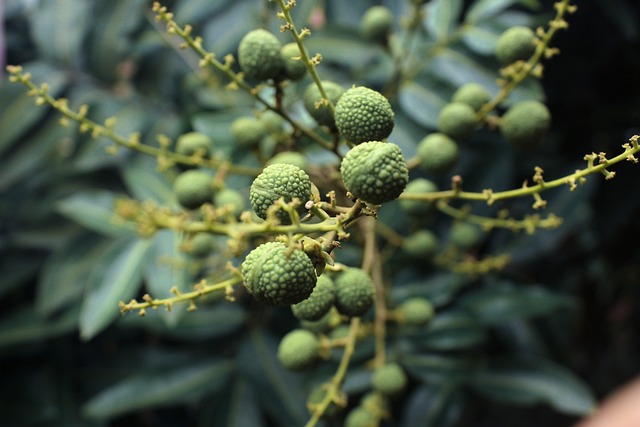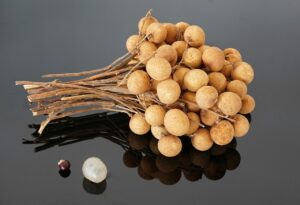Table of Contents

Overview
Longan fruit, also known as “dragon’s eye,” is a tropical fruit that is not only delicious but also packed with numerous health benefits. Its unique taste, juicy flesh, and various nutrients make it a popular choice among fruit enthusiasts. In this article, we will explore the exceptional nutritional benefits, Culinary delights, Cultivation of longan fruit and why you should consider adding it to your diet. So, let’s dive in and discover the wonders of this exotic fruit.
The Nutritional Benefits
1. Rich in Antioxidants for a Healthy Body
This fruit is a rich source of antioxidants, which play a crucial role in protecting our body against the damaging effects of free radicals. These free radicals can lead to oxidative stress, causing various health issues. However, by consuming it, you can boost your antioxidant intake and promote overall well-being.
2. High in Vitamin C: Boosting Immunity
One of the standout nutritional benefits of longan fruit is its impressive vitamin C content. Vitamin C is well-known for its immune-boosting properties, helping to strengthen the body’s defense system against common illnesses and infections. Incorporating this fruit into your diet can contribute to maintaining a healthy immune system.
3. Good Source of Essential Minerals
It is packed with essential minerals, including potassium, magnesium, and iron. These minerals in this fruit help in maintaining proper bodily functions. Potassium helps regulate blood pressure, while magnesium promotes healthy bones and muscles. Iron is most essential mineral for production of red blood cells and thus preventing anemia. By consuming this fruit, you can ensure a balanced intake of these essential minerals.
4. A Natural Energy Booster
If you’re in need of a natural energy boost, this fruit can be your go-to snack. The fruit contains natural sugars that provide a quick and healthy source of energy. Instead of reaching for sugary processed snacks, enjoy the natural sweetness and energy-enhancing benefits of longan fruit.
5. Supports Digestive Health
It provides ample amount of dietary fiber, which is important for a healthy digestive system. Fiber helps to improve digestion, prevent constipation, and improve bowel movements. By incorporating longan fruit into your diet, you can support your digestive health and enjoy its sweet and juicy flavor at the same time.
6. Promotes Healthy Skin and Hair.
If you desire healthy and radiant skin, this fruit can be an excellent addition to your skincare routine. The fruit contains antioxidants and vitamins that nourish the skin, helping to maintain its elasticity and youthful appearance. Additionally, the high water content in longan fruit helps keep the skin hydrated. Moreover, the vitamins and minerals present in it contribute to healthy hair growth, making it a holistic choice for both skin and hair care.
Exploring the Culinary Delights

Longan fruit, other than being a nutritious fruit, it is also a versatile ingredient that can elevate various culinary creations. With its sweet and floral flavor, juicy texture, and distinctive appearance, longan fruit adds a tropical twist to a wide range of dishes and beverages. So, let’s embark on a flavorful journey through the culinary world of this fruit.
1. Fresh and Simple: Enjoying as a Snack
Sometimes, the best way to savor the true essence of a fruit is by enjoying it in its simplest form. Longan fruit is no exception. The succulent flesh of the fruit, with its delicate sweetness, can be relished as a refreshing snack on its own. Simply peel the thin skin, reveal the translucent fruit, and pop it into your mouth for a burst of tropical flavor. Its natural juiciness and unique taste make this fruit a delightful treat for all fruit enthusiasts.
2. Exquisite Desserts with Longan Fruit
This fruit can be the star ingredient in a plethora of delectable desserts. Its inherent sweetness and juicy texture make it a perfect addition to cakes, pastries, and puddings. Here are a few mouthwatering dessert ideas featuring this fruit:
Longan Fruit Tart:
Create a luscious tart filled with a creamy custard base and topped with fresh longan fruit for an elegant and visually stunning dessert.
Longan Sorbet:
Blend this fruit with a touch of lime juice and freeze it to create a refreshing and palate-cleansing sorbet that will tantalize your taste buds.
Longan Panna Cotta:
Infuse the delicate flavor of longan fruit into a silky-smooth panna cotta, garnished with fresh longan fruit for an exquisite dessert experience.
3. Culinary Fusion: Longan Fruit in Savory Dishes
Beyond desserts, longan fruit can lend its unique flavor profile to savory dishes, adding an unexpected twist to your culinary creations. Here are a few ways to incorporate this fruit into your savory recipes:
Longan Fruit Salsa:
Combine diced longan fruit with chopped red onions, bell peppers, cilantro, and a splash of lime juice for a refreshing and tangy salsa that pairs well with grilled meat dishes or as a topping on tacos.
Longan Chicken Stir-Fry:
Add fresh longan fruit to a stir-fry with chicken, vegetables, and a flavorful sauce for a harmonious blend of sweet and savory notes.
Longan Fruit Salad:
Create a vibrant fruit salad by combining longan fruit with other tropical fruits like mango, pineapple, and papaya. Drizzle with a honey-lime dressing for a burst of tropical goodness.
4. Longan-infused Beverages: Quench Your Thirst in Style
Longan fruit can also transform your beverages into exotic and refreshing delights. Here are a few ideas to infuse the flavors of this fruit into your drinks:
Longan Fruit Smoothie:
Blend fresh longan fruit with yogurt, banana, and a splash of coconut water for a creamy and tropical smoothie that will transport you to a sunny paradise.
Longan Iced Tea:
Brew a pot of your favorite tea and add this fruit to infuse its delicate sweetness into the beverage. Chill it, pour over ice, and garnish with mint leaves for a revitalizing summer drink.
Longan Fruit Infused Water:
Add slices of longan fruit to a pitcher of water and let it infuse for a few hours in the refrigerator. Enjoy the subtly flavored water that provides a hint of tropical indulgence.
Growing Longan Fruit
Longan fruit can be grown in suitable climates, allowing you to enjoy its fresh flavors right from your own garden. If you’re interested in cultivating longan fruit trees and reaping the rewards of a bountiful harvest, this section will provide you with essential tips and guidelines to help you successfully grow this fruit. Let’s get started on your journey to cultivating this remarkable fruit.
1. Climate and Soil Requirements
Longan trees thrive in warm, tropical climates, ideally USDA hardiness zones 10 to 11. They require temperatures between 68°F and 95°F (20°C and 35°C) for optimal growth. Select a sunny location for your longan tree, as it prefers full sun exposure to produce abundant fruit.
When it comes to soil, longan trees prefer well-drained soil with a slightly acidic to neutral pH. Ensure good drainage to prevent waterlogging, as longan trees are susceptible to root rot. Sandy loam or loamy soil with good organic matter content is ideal for their growth.
2. Choosing the Right Variety and Planting Method
Selecting a suitable longan variety is crucial for a successful harvest. Choose a variety that is well-adapted to your climate and offers good fruit quality. Common varieties include ‘Kohala,’ ‘Biew Kiew,’ and ‘Champoo.’
When planting longan trees, consider the spacing requirements. Provide ample space between trees, typically around 25 to 30 feet apart, as longan trees can grow up to 30 feet tall and have a spreading canopy. This allows sufficient air circulation and sunlight penetration for proper growth.
3. Watering and Fertilization
Longan trees require regular watering, especially during dry spells or when they are establishing themselves. Keep the soil moist but avoid overwatering, as excessive moisture can lead to root rot. Deep watering once or twice a week, depending on the weather conditions, is generally sufficient.
Fertilize your longan tree regularly to provide it with the necessary nutrients. Apply a balanced fertilizer, preferably one specifically formulated for fruit trees, according to the manufacturer’s instructions. Fertilize during the growing season, typically in spring and summer, to promote healthy growth and fruit development.
4. Pruning and Training
Proper pruning and training are essential for longan trees to maintain their shape, encourage fruiting, and promote good air circulation. Prune your longan tree during the dormant season, removing any dead, diseased, or crossing branches. Maintain an open center or vase shape to allow sunlight to reach all parts of the tree.
Thinning the fruit clusters is important to prevent overcrowding and promote better fruit development. Thin the clusters when the fruits are small, leaving a few well-spaced fruits per cluster for optimal growth.
5. Pest and Disease Management
Longan trees are susceptible to certain pests and diseases, including fruit flies, mealybugs, scale insects, and anthracnose. Regular inspection of trees is necessary to spot any signs of pest infestation or disease symptoms. Consult with local agricultural extension services or horticulture experts for suitable pest control measures and disease management strategies.
6. Harvesting and Enjoying the Fruits
This fruit is typically ready for harvest 100 to 120 days after flowering. The fruits turn from green to a reddish-brown color when fully ripe. Gently twist or cut.
The Seasonality
Longan fruit, scientifically known as Dimocarpus longan, is a tropical fruit that delights taste buds with its sweet and juicy flesh. Like many fruits, longan has a specific season when it is at its peak freshness and flavor. Understanding the seasonality of this fruit is essential for enjoying it at its best and incorporating it into your culinary creations. In this article, we will explore the seasonality of it, including when it is available, how to identify ripe fruit, and the best ways to savor its succulent flavors.
1. Season and Availability
Longan fruit has a distinct growing season that varies depending on the region and climate. In general, the peak season for this fruit falls during the late summer and early autumn months. The exact timing may differ based on geographical location and local growing conditions. In tropical and subtropical regions, this fruit is typically harvested from July to September.
During the season, this fruit can be found in abundance at local markets, fruit stands, and specialty grocery stores in the regions where it is cultivated. Look for fresh longan fruit with intact skins and a vibrant color to ensure its quality and ripeness.
2. Identifying Ripe Longan Fruit
Knowing how to identify ripe longan fruit is crucial to enjoy its delectable flavors to the fullest. Here are some key characteristics to look for when selecting ripe longan fruit:
Color:
Ripe longan fruit typically has a light brown or reddish-brown skin color. Avoid fruits with green or unripe-looking skins.
Texture:
Gently squeeze the fruit. Ripe longan fruit should feel firm but slightly yielding to the touch. It should not be softer or pulpy.
Fruit-to-Seed Ratio:
Ripe longan fruit usually has a high fruit-to-seed ratio, meaning there is more fruit flesh than seed. Look for plump and full fruits.
Aroma:
Ripe longan fruit emits a sweet and floral aroma. Sniff the fruit to detect its fragrant scent, which indicates its ripeness.
To sum it up
Longan fruit is a tropical gem that delights both the palate and the senses. With its sweet and juicy flesh, rich nutritional profile, and unique flavors, this fruit offers a delightful culinary experience. Whether you enjoy it fresh, incorporate it into various dishes, or visit a longan fruit farm for an immersive journey, this fruit never fails to impress. So, embrace the opportunity to savor the wonders of longan fruit and let it transport you to a tropical paradise with every delicious bite.

